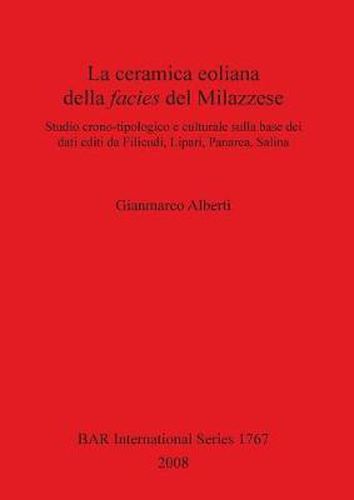Readings Newsletter
Become a Readings Member to make your shopping experience even easier.
Sign in or sign up for free!
You’re not far away from qualifying for FREE standard shipping within Australia
You’ve qualified for FREE standard shipping within Australia
The cart is loading…






This title is printed to order. This book may have been self-published. If so, we cannot guarantee the quality of the content. In the main most books will have gone through the editing process however some may not. We therefore suggest that you be aware of this before ordering this book. If in doubt check either the author or publisher’s details as we are unable to accept any returns unless they are faulty. Please contact us if you have any questions.
This study deals with the ceramic repertoire of the Aeolian Middle Bronze Age culture, the so called Milazzese facies. The work takes into account the edited documentation from the four main settlements on the Aeolian Archipelago, unearthed by Luigi Bernabo Brea in several excavations between 1940 and 1970. These settlements are on the Montagnola of Filicudi, the Acropolis of Lipari, Capo Milazzese at Panarea, and at Portella on the island of Salina. At the latter site, more recent excavations are also taken into account in this present study. The aim of this work is twofold: to devise a formalized typology for the Milazzese ceramic repertoire (to be used as a basis for the chrono-typological analysis of the pottery assemblages) and to assess the chronological and typological achievements in an historical and, broadly speaking, cultural perspective. Chapter 1 provides a description of the Milazzese facies and of the various aspects of its material culture. Chapter 2 deals with the problem of the stratigraphy of the Aeolian MBA settlements. Chapter 3 looks at Aegean pottery from Milazzese contexts. Chapter 4 devises a formalized typology for the Milazzese pottery assemblage. Chapter 5 deals with the seriation of the Milazzese ceramic assemblage. Chapter 6 describes the Milazzese ceramic repertoire’s development and attempts to read this phenomenon in a cultural perspective. Three data Appendices and catalogue are provided.
$9.00 standard shipping within Australia
FREE standard shipping within Australia for orders over $100.00
Express & International shipping calculated at checkout
This title is printed to order. This book may have been self-published. If so, we cannot guarantee the quality of the content. In the main most books will have gone through the editing process however some may not. We therefore suggest that you be aware of this before ordering this book. If in doubt check either the author or publisher’s details as we are unable to accept any returns unless they are faulty. Please contact us if you have any questions.
This study deals with the ceramic repertoire of the Aeolian Middle Bronze Age culture, the so called Milazzese facies. The work takes into account the edited documentation from the four main settlements on the Aeolian Archipelago, unearthed by Luigi Bernabo Brea in several excavations between 1940 and 1970. These settlements are on the Montagnola of Filicudi, the Acropolis of Lipari, Capo Milazzese at Panarea, and at Portella on the island of Salina. At the latter site, more recent excavations are also taken into account in this present study. The aim of this work is twofold: to devise a formalized typology for the Milazzese ceramic repertoire (to be used as a basis for the chrono-typological analysis of the pottery assemblages) and to assess the chronological and typological achievements in an historical and, broadly speaking, cultural perspective. Chapter 1 provides a description of the Milazzese facies and of the various aspects of its material culture. Chapter 2 deals with the problem of the stratigraphy of the Aeolian MBA settlements. Chapter 3 looks at Aegean pottery from Milazzese contexts. Chapter 4 devises a formalized typology for the Milazzese pottery assemblage. Chapter 5 deals with the seriation of the Milazzese ceramic assemblage. Chapter 6 describes the Milazzese ceramic repertoire’s development and attempts to read this phenomenon in a cultural perspective. Three data Appendices and catalogue are provided.